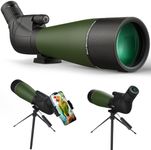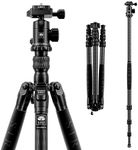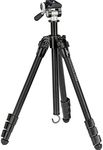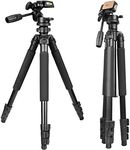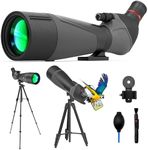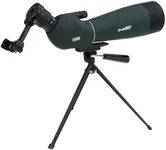Buying Guide for the Best Tripod For Spotting Scopes
Choosing the right tripod for your spotting scope is crucial for ensuring stability, ease of use, and overall satisfaction during your outdoor adventures. A good tripod will provide a steady platform for your scope, allowing you to observe wildlife, landscapes, or celestial objects without any unwanted movement. When selecting a tripod, consider the following key specifications to find the best fit for your needs.Weight CapacityWeight capacity refers to the maximum weight a tripod can support. This is important because your tripod needs to be able to hold your spotting scope securely without tipping over or collapsing. Tripods with higher weight capacities are generally more stable but can be heavier and bulkier. If you have a lightweight spotting scope, a tripod with a lower weight capacity will suffice. However, for heavier scopes, opt for a tripod with a higher weight capacity to ensure stability.
Height RangeThe height range of a tripod indicates how tall it can extend and how compact it can become when folded. This is important for both usability and portability. A tripod with a wide height range allows you to use it comfortably whether you are standing or sitting. For taller users or those who prefer to stand while observing, a tripod with a higher maximum height is ideal. Conversely, if you need a compact tripod for travel or hiking, look for one with a shorter folded length.
MaterialTripods are typically made from aluminum or carbon fiber. The material affects the tripod's weight, durability, and cost. Aluminum tripods are generally more affordable and durable but can be heavier. Carbon fiber tripods are lighter and more resistant to vibrations, making them ideal for long hikes and extended use, but they tend to be more expensive. Choose a material based on your need for portability versus durability and budget considerations.
Leg LocksLeg locks are mechanisms that secure the tripod legs at a desired length. There are two main types: flip locks and twist locks. Flip locks are quick and easy to use, making them ideal for fast setup. Twist locks are more compact and can provide a sleeker look but may take a bit longer to adjust. Consider how quickly you need to set up your tripod and your preference for ease of use when choosing between these two types.
Head TypeThe head of the tripod is where the spotting scope attaches, and it allows for movement and adjustment. There are several types of heads, including pan-tilt heads and ball heads. Pan-tilt heads offer precise control over horizontal and vertical movements, making them ideal for tracking moving subjects. Ball heads provide more flexibility and quicker adjustments but may be less precise. Choose a head type based on your observation needs and how much control you require over your scope's positioning.
PortabilityPortability refers to how easy it is to carry the tripod, especially during long hikes or travel. This is influenced by the tripod's weight, folded length, and whether it comes with a carrying case. If you plan to move around a lot or travel with your tripod, look for a lightweight model that folds down compactly and includes a carrying case or strap. For stationary use, portability may be less of a concern, allowing you to prioritize other features.
